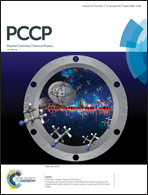Formation of a solid solution between [N(C2H5)4][BF4] and [N(C2H5)4][PF6] in crystal and plastic crystal phases†
Abstract
The phase behavior of [N2222][BF4] and [N2222][PF6] (N2222+ = tetraethylammonium cation) binary systems has been investigated in the present study. Differential scanning calorimetry revealed that the crystal-to-plastic-crystal transition temperature decreases upon mixing the two salts, with a minimum at x([N2222][PF6]) = 0.4, where x([N2222][PF6]) denotes the molar fraction of [N2222][PF6]. Powder X-ray diffraction analysis indicated the formation of a solid solution with a rock-salt type structure in the plastic crystal phase at all ratios and the lattice parameter a changes according to Vegard's law. In the crystal phase, two solid solution phases based on the structures of the single salts are observed. Raman spectroscopy confirmed the changes in the solid–solid transition temperature as observed by differential scanning calorimetry. Consequently, in the resulting phase diagram, the solid solution is formed in a wide x([N2222][PF6]) range for both the crystal and plastic crystal phases.
![Graphical abstract: Formation of a solid solution between [N(C2H5)4][BF4] and [N(C2H5)4][PF6] in crystal and plastic crystal phases](/en/Image/Get?imageInfo.ImageType=GA&imageInfo.ImageIdentifier.ManuscriptID=C6CP07992J&imageInfo.ImageIdentifier.Year=2017)


 Please wait while we load your content...
Please wait while we load your content...